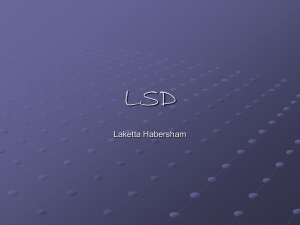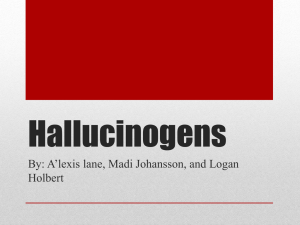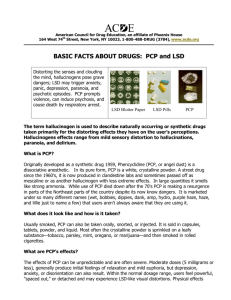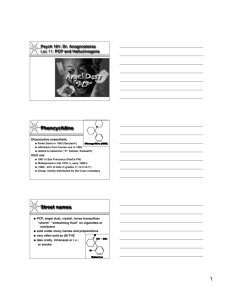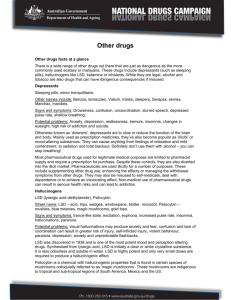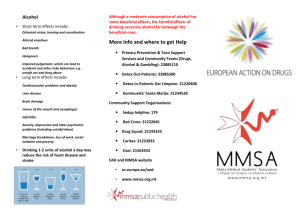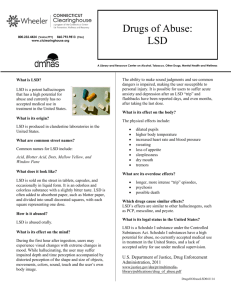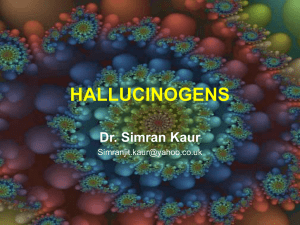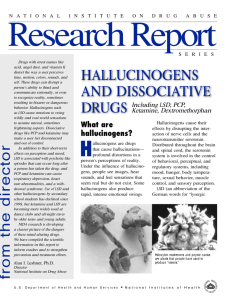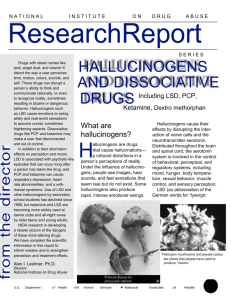NIDA Research Report- Hallucinogens and Dissociative
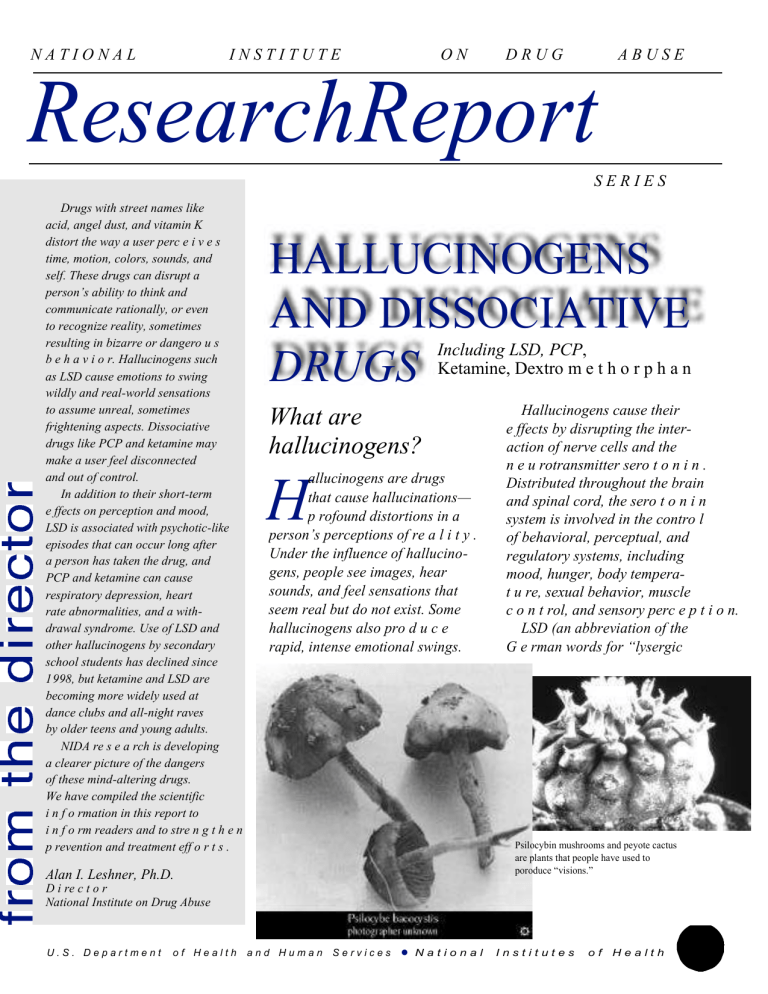
I N S T I T U T E O N D R U G N A T I O N A L
ResearchReport
A B U S E
S E R I E S
Drugs with street names like acid, angel dust, and vitamin K distort the way a user perc e i v e s time, motion, colors, sounds, and self. These drugs can disrupt a person’s ability to think and communicate rationally, or even to recognize reality, sometimes resulting in bizarre or dangero u s b e h a v i o r. Hallucinogens such as LSD cause emotions to swing wildly and real-world sensations to assume unreal, sometimes frightening aspects. Dissociative drugs like PCP and ketamine may make a user feel disconnected and out of control.
In addition to their short-term e ffects on perception and mood,
LSD is associated with psychotic-like episodes that can occur long after a person has taken the drug, and
PCP and ketamine can cause respiratory depression, heart rate abnormalities, and a with- drawal syndrome. Use of LSD and other hallucinogens by secondary school students has declined since
1 9 98, but ketamine and LSD are becoming more widely used at dance clubs and all-night raves by older teens and young adults.
NIDA re s e a rch is developing a clearer picture of the dangers of these mind-altering drugs.
We have compiled the scientific i n f o rmation in this report to i n f o rm readers and to stre n g t h e n p revention and treatment eff o r t s .
HALLUCINOGENS
AND DISSOCIATIVE
DRUGS
Including LSD, PCP
,
Ketamine, Dextro m e t h o r p h a n
What are hallucinogens?
H allucinogens are drugs that cause hallucinations— p rofound distortions in a person’s perceptions of re a l i t y .
Under the influence of hallucino- gens, people see images, hear sounds, and feel sensations that seem real but do not exist. Some hallucinogens also pro d u c e rapid, intense emotional swings.
Hallucinogens cause their e ffects by disrupting the inter- action of nerve cells and the n e u rotransmitter sero t o n i n .
Distributed throughout the brain and spinal cord, the sero t o n i n system is involved in the contro l of behavioral, perceptual, and regulatory systems, including mood, hunger, body tempera- t u re, sexual behavior, muscle c o n t rol, and sensory perc e p t i o n.
LSD (an abbreviation of the
G e rman words for “lysergic
Psilocybin mushrooms and peyote cactus are plants that people have used to poroduce “visions.”
Alan I. Leshner, Ph.D.
D i re c t o r
National Institute on Drug Abuse
U . S . D e p a r t m e n t o f H e a l t h a n d H u m a n S e r v i c e s
•
N a t i o n a l I n s t i t u t e s o f H e a l t h
2
NIDA RESEARCH REPORT SERIES acid diethylamide”) is the drug most commonly identified with the term “hallucinogen” and the most widely used in this class of drugs. It is considered the typical hallucinogen, and the character- istics of its action and eff e c t s described in this Research Report apply to the other hallucinogens, including mescaline, psilocybin, and ibogaine.
What are dissociative drugs?
D rugs such as PCP (phen- cyclidine) and ketamine, which were initially developed as general anesthetics for surgery, distort perceptions of sight and sound and produce feelings of detachment— dissociation — from the environ- ment and self. But these mind- altering effects are not hallucinations. PCP and ketamine a re there f o re more properly known as “dissociative anesthet- ics.” Dextromethorphan, a widely available cough suppre s s a n t , when taken in high doses can p roduce effects similar to those of PCP and ketamine.
The dissociative drugs act by altering distribution of the neuro- transmitter glutamate throughout the brain. Glutamate is involved in perception of pain, responses to the environment, and memory.
PCP is considered the typical dissociative drug, and the description of PCP’s actions and effects in this Research Report largely applies to ketamine and dextromethorphan as well.
Why do people take hallucinogens?
H allucinogenic drugs have played a role in human life for thousands of years.
C u l t u res from the tropics to the a rctic have used plants to induce states of detachment from reality and to precipitate “visions” thought to provide mystical insight. These plants contain chemical compounds, such as mescaline, psilocybin, and ibo- gaine, that are structurally similar to serotonin, and they produce their effects by disrupting norm a l functioning of the serotonin sys- tem. Historically, hallucinogenic plants were used largely for social and religious ritual, and their availability was limited by
Prevalence of Students Who Have Ever Used Hallucinogens and PCP
14%
12
10
8
2
0
6
4
14% n n n n
12
10 n s l s l s l s l s l
8
2
0
1992 1994 1996 1998 2000
LSD
6
4
14%
12
10 n s l n n s n s
8
6 s l s l l l
4
2
1992 1994 1996 1998 2000
0
Other Hallucinogens n n s l
12th-graders
10th-graders
8th-graders
(Data not available for
8th- and 10th-graders) n n n n
1992 1994 1996 1998 2000
PCP
Source: Monitoring the Future Survey, 2000
NIDA
RESEARCH REPORT SERIES
3 the climate and soil conditions they require. After the develop- ment of LSD, a synthetic com- pound that can be manufacture d anywhere, abuse of hallucino- gens became more widespread , and from the 1960s it increased dramatically. All LSD manufac- tured in this country is intended for illegal use, since LSD has no accepted medical use in the
United States.
Physical characteristics of LSD
LSD is a clear or white, odorless, water-soluble material synthe- sized from lysergic acid, a compound derived from a rye fungus. LSD is the most potent mood- and perception-altering drug known: oral doses as small as 30 micrograms can produce effects that last 6 to 12 hours.
LSD is initially produced in crystalline form. The pure crystal can be crushed to powder and mixed with binding agents to produce tablets known as
“ microdots” or thin squares of gelatin called “window panes”; more commonly, it is dissolved, diluted, and applied to paper or other materials. The most common form of LSD is called
“blotter acid”—sheets of paper soaked in LSD and perforated into 1/4-inch square, individual dosage units. Variations in manu- facturing and the presence of contaminants can produce LSD in colors ranging from clear or white, in its purest form, to tan or even black. Even uncontami- nated LSD begins to degrade and
C hemist Albert Hofmann, working at the Sandoz
Corporation pharmaceutical laboratory in Switzerland, first synthesized LSD in 1938. He was conducting research on possible medical applications of various lysergic acid compounds derived from ergot, a fungus that develops on rye grass. Searching for compounds with therapeutic value, Hofmann created more than two dozen ergot-derived synthetic molecules. The 25th was called, in German,
Lyserg-Säure-Diäthylamid 25, or LSD-25. Five years after he first created the drug, Hofmann accidentally ingested a small amount and experienced a series of frightening sensory effects :
“My surroundings . . . transformed themselves in more terrifying ways. Everything in the room spun around , and the familiar objects and pieces of furniture assumed g rotesque, threatening forms. They were in continuous motion, animated, as if driven by an inner restlessness
. . . . Even worse than these demonic transform at ions of the outer world were the alterations that I perceived in myself, in my inner being. Every exertion of my will, every attempt to put an end to the disintegration of the outer world and the dissolution of my ego, seemed to be wasted effort. A demon had invaded me, had taken possession of my body, mind, and soul.” discolor soon after it is manufac- tured, and drug distributors often apply LSD to colored paper, making it difficult for a buyer to determine the drug’s purity or age.
L S D ’s effects
The precise mechanism by which
LSD alters perceptions is still unclear. Evidence from laborato- ry studies suggests that LSD, like hallucinogenic plants, acts on certain groups of serotonin receptors designated the 5-HT
2 receptors, and that its effects are most prominent in two brain regions: One is the cerebral cor- tex, an area involved in mood, cognition, and perception; the other is the locus ceruleus, which receives sensory signals f rom all areas of the body and has been described as the brain’s
“novelty detector” for important external stimuli.
LSD’s effects typically begin within 30 to 90 minutes of inges- tion and may last as long as
4
NIDA RESEARCH REPORT SERIES
Structure of Serotonin and Selected Hallucinogens
SEROTONIN LYSERGIC ACID
DIETHYLAMIDE - LSD
PSILOCYBIN MESCALINE
Hallucinogenic drugs are much like the neurotransmitter serotonin in their molecular structure as well as where and how they act in the brain.
1 2 hours. Users refer to LSD and other hallucinogenic experi- ences as “trips” and to the acute adverse experiences as “bad trips.” Although most LSD trips include both pleasant and unpleasant aspects, the drug’s effects are unpredictable and may vary with the amount ingested and the user’s person- ality, mood, expectations, and surroundings.
Users of LSD may experience some physiological effects, such as increased blood pressure and heart rate, dizziness, loss of appetite, dry mouth, sweating, nausea, numbness, and tremors ; but the drug’s major effects are emotional and sensory. The user’s emotions may shift rapidly through a range from fear to euphoria, with transitions so rapid that the user may seem to experience several emotions simultaneously .
LSD also has dramatic effects on the senses. Colors, smells, sounds, and other sensations seem highly intensified. In some
cases, sensory perceptions may blend in a phenomenon known as synesthesia, in which a person seems to hear or feel colors and see sounds.
Hallucinations distort or trans- f o rm shapes and movements, and they may give rise to a per- ception that time is moving very slowly or that the user’s body is changing shape. On some trips, users experience sensations that a re enjoyable and mentally stim- ulating and that produce a sense of heightened understanding.
Bad trips, however, include terri- fying thoughts and nightmarish feelings of anxiety and despair that include fears of insanity, death, or losing contro l .
LSD users quickly develop a high degree of tolerance for the drug’s effects: After repeated use, they need increasingly larg e r doses to produce similar eff e c t s .
LSD use also produces tolerance for other hallucinogenic drugs such as psilocybin and mescaline, but not to drugs such as mari- juana, amphetamines, and PCP, which do not act directly on the serotonin receptors affected by
LSD. Tolerance for LSD is short- lived—it is lost if the user stops taking the drug for several days.
There is no evidence that LSD produces physical withdrawal symptoms when chronic use is stopped.
Two long-term effects — persistent psychosis and hallu- cinogen persisting perception disorder (HPPD), more common- ly referred to as “flashbacks”— have been associated with use of LSD. The causes of these e ffects, which in some users occur after a single experience with the drug, are not known.
Psychosis.
The effects of
LSD can be described as drug- induced psychosis—distortion or disorganization of a person’s capacity to recognize re a l i t y , think rationally, or communicate with others. Some LSD users experience devastating psycho- logical effects that persist after the trip has ended, producing a long-lasting psychotic-like state.
LSD-induced persistent psychosis may include dramatic mood swings from mania to profound depression, vivid visual disturb - ances, and hallucinations. These effects may last for years and can affect people who have no history or other symptoms of psychological disorder.
Hallucinogen Persisting
Perception Disorder
: Some former LSD users report experi- ences known colloquially as
“flashbacks” and called “HPPD” by physicians. These episodes are spontaneous, repeated, sometimes continuous recur- rences of some of the sensory distortions originally produced by LSD. The experience may include hallucinations, but it most commonly consists of visual disturbances such as seeing false motion on the edges of the field of vision, bright or colored flash- es, and halos or trails attached to moving objects. This condition is typically persistent and in some cases remains unchanged for years after individuals have stopped using the drug.
NIDA
RESEARCH REPORT SERIES
5
Because HPPD symptoms may be mistaken for those of other neurological disorders such as stroke or brain tumors, sufferers may consult a variety of clinicians before the disorder is accurately diagnosed. There is no estab- lished treatment for HPPD, although some antidepressant drugs may reduce the symptoms.
Psychotherapy may help patients adjust to the confusion associated with visual distraction and to minimize the fear, expressed by some, that they are suffering brain damage or psychiatric disorder.
What are the facts about dissociative drugs?
P C P ’s forms and effects
P
C P, developed in the 1950s as an intravenous surgical anesthetic, is classified as a dissociative anesthetic: Its seda- tive and anesthetic effects are trance-like, and patients experi- ence a feeling of being “out of body” and detached from their environment. PCP was used in veterinary medicine but was never approved for human use because of problems that arose during clinical studies, including delirium and extreme agitation experienced by patients emerging f rom anesthesia.
During the 1960s, PCP in pill form became widely abused, but the surge in illicit use receded rapidly as users became dissatis- fied with the long delay between
L S D n acid n blotter n blotter acid n dots n microdot n pane n paper acid n sugar n sugar cubes n trip n window glass n window pane n Zen
K e t a m i n e n bump n cat Valium n green n honey oil n jet n K n purple n Special K n special la coke n n super acid super C n vitamin K
P C P n angel n angel dust n boat n dummy dust n love boat n peace n supergrass n zombie
6
NIDA RESEARCH REPORT SERIES taking the drug and feeling its e ffects, and with the unpre- dictable and often violent behavior associated with its use.
Street Names for
Hallucinogens and
Dissociative Drugs
Powdered PCP—known as
“ozone,” “rocket fuel,” “love boat,” “hog,” “embalming fluid,” or “superweed”—appeared in the 1970s. In powdered form, the drug is sprinkled on marijuana, tobacco, or parsley, then smoked, and the onset of effects is rapid.
Users sometimes ingest PCP by snorting the powder or by swal- lowing it in tablet form. Normally a white crystalline powder, PCP is sometimes colored with water- soluble or alcohol-soluble dyes.
When snorted or smoked,
PCP rapidly passes to the brain to disrupt the functioning of sites known as NMDA
( N -methyl-D-aspartate) receptor complexes, which are receptors for the neurotransmitter gluta- mate. Glutamate receptors play a major role in the perception of pain, in cognition—including learning and memory— and in emotion. In the brain, PCP also alters the actions of dopamine, a neurotransmitter responsible for the euphoria and “rush” associated with many abused drugs .
At low PCP doses (5 mg or less), physical effects include shallow, rapid breathing , increased blood pressure and heart rate, and elevated tempera- ture. Doses of 10 mg or more cause dangerous changes in blood pressure, heart rate, and respiration, often accompanied by nausea, blurred vision, dizzi- ness, and decreased awareness of pain. Muscle contractions may cause uncoordinated movements and bizarre postures. When severe, the muscle contractions can result in bone fracture or in kidney damage or failure as a consequence of muscle cells b reaking down. Very high doses of PCP can cause convulsions, coma, hyperthermia, and death.
PCP’s effects are unpredictable.
Typically, they are felt within minutes of ingestion and last for several hours. Some users report feeling the drug’s effects for days. One drug-taking episode may produce feelings of detach- ment from reality, including distortions of space, time, and body image; another may pro- duce hallucinations, panic, and fear. Some users report feelings of invulnerability and exagger- ated strength. PCP users may become severely disoriented, violent, or suicidal.
Repeated use of PCP can result in addiction, and recent research suggests that repeated or prolonged use of PCP can cause withdrawal syndrome when drug use is stopped.
Symptoms such as memory loss and depression may persist for as long as a year after a chronic user stops taking PCP.
N a t u re and effects of ketamine
Ketamine (“K,” “Special K,”
“cat Valium”) is a dissociative anesthetic developed in 1963 to replace PCP and currently used in human anesthesia and veterinary medicine. Much of the ketamine sold on the street has been diverted from veterinarians’ offices. Although it is manufac- tured as an injectable liquid, in illicit use ketamine is generally
Extra-strength cough syrup is the most common source of abused dextromethorphan. evaporated to form a powder that is snorted or compressed into pills.
Ketamine’s chemical structure and mechanism of action are similar to those of PCP, and its e ffects are similar, but ketamine is much less potent than PCP with effects of much shorter duration. Users report sensations ranging from a pleasant feeling of floating to being separated f rom their bodies. Some keta- mine experiences involve a terrifying feeling of almost com- plete sensory detachment that is likened to a near-death experi- ence. These experiences, similar to a “bad trip” on LSD, are called the “K-hole.”
Ketamine is odorless and taste- less, so it can be added to bever- ages without being detected, and it induces amnesia. Because of these properties, the drug is sometimes given to unsuspecting victims and used in the commis- sion of sexual assaults referred to as “drug rape.”
N a t u re and effects of dextro m e t h o r p h a n
Dextromethorphan (sometimes called “DXM” or “robo”) is a cough-suppressing ingredient in a variety of over-the-counter cold and cough medications. Like PCP and ketamine, dextromethorphan acts as an NMDA receptor antag- onist. The most common source of abused dextromethorphan is
“extra-strength” cough syrup, which typically contains 3 mil- ligrams of the drug per milliliter of syrup. At the doses recom- mended for treating coughs
(1/6 to 1/3 ounce of medication, containing 15 mg to 30 mg dextromethorphan), the drug is safe and effective. At much higher doses (4 or more ounces), dextromethorphan produces dissociative effects similar to those of PCP and ketamine.
NIDA
RESEARCH REPORT SERIES
7
The effects vary with dose, and dextromethorphan users describe a set of distinct dose-dependent
“plateaus” ranging from a mild stimulant effect with distorted visual perceptions at low
( approximately 2-ounce) doses to a sense of complete dissocia- tion from one’s body at doses of
1 0 ounces or more. The effects typically last for 6 hours. Over- the-counter medications that contain dextromethorphan often contain antihistamine and decon- gestant ingredients as well, and high doses of these mixtures can seriously increase risks of dextromethorphan abuse.
Where can I get more scientific information on hallucinogens and dissociative drugs?
F act sheets on LSD, PCP, other illicit drugs, and related topics a re available free, in English and Spanish, with a call to NIDA
Infofax at 1-888-NIH-NIDA
(1-888-644-6432) or, for the deaf,
1-888-TTY-NIDA (1-888-889-6432).
Further information on hallucinogens and dissociative drugs can be obtained also through NIDA’s home page
(www.drugabuse.gov) and fro m the National Clearinghouse for
Alcohol and Drug Information
(NCADI) at 1-800-729-6686.
NCADI’s Web site is www.health.org .
8
NIDA RESEARCH REPORT SERIES
G l o s s a ry
Acid : Common street name for LSD.
Angel dust: Common street name for PCP.
Cerebral cortex : Region of the brain responsi- ble for cognitive functions including reasoning , mood, and perception of stimuli.
Dissociative anesthetic: Compound, such as phencyclidine or ketamine, that produces an anesthetic effect characterized by a feeling of being detached from the physical self.
DXM: Common street name for dextro methor- phan .
Flashback : Slang term for HPPD (see below).
Glutamate : A neurotransmitter associated with pain, memory, and response to changes in the environment.
Hallucinogen : A drug that produces hallucinations — distortion in perception of sights and sounds—and disturbances in emotion, judgment, and memory.
HPPD: Hallucinogen persisting perception disorder; the spontaneous and sometimes con- tinuous recurrence of perceptual effects of LSD long after an individual has ingested the dru g .
Ketamine: Dissociative anesthetic abused for its mind-altering effects and sometimes used to facilitate sexual assault.
Locus ceruleus : Region of the brain that receives and processes sensory signals from all a reas of the body.
Neurotransmitter: Chemical compound that acts as a messenger to carry signals or stimuli f rom one nerve cell to another.
NMDA: N - methyl - D - aspartate, a chemical compound that reacts with glutamate receptors on nerve cells.
PCP: Phencyclidine, a dissociative anesthetic abused for its mind-altering effects .
Persistent psychosis: Unpredictable and long-lasting visual disturbances, dramatic mood swings, and hallucinations experienced by some LSD users after they have discontinued use of the drug.
Robo : Common street name for dextromethorphan .
Serotonin: A neurotransmitter that causes a very broad range of effects on perception , movement, and the emotions by modulating the actions of other neurotransmitters in most parts of the brain.
R e f e re n c e s
Abraham, H.D.; Aldridge, A.M.; and Gogia, P.
The psychopharmacology of hallucinogens.
Aghajanian, G.K., and Marek, G.J. Serotonin and hallucinogens. N e u ro p s y c h o p h a rm a c o l o g y
2 1 : 16S-23S, 1999.
B a c k s t rom, J.R.; Chang, M.S.; Chu, H.; Niswender,
C.M.; and Sanders-Bush, E. Agonist-directed sig- naling of serotonin 5-HT
2 c receptors: diff e re n c e s between serotonin and lysergic acid diethylamide
1 9 9 9 .
C a rroll, M.E. PCP and hallucinogens.
Alcohol and Substance Abuse
1 9 9 0 .
Advances in
9 (1-2): 167-190,
Christophersen, A.S. Amphetamine designer dru g s : an overview and epidemiology. To x i c o l o g y
Frankenheim, J. , and Lin, G.C. Hallucinogenic
D rugs. In: Craighead, W.E., and Nemero ff, C., eds. Encyclopedia of Psychology and in pre s s .
Hofmann, A. LSD: My Problem Child.
McGraw-Hill, 1980.
New Yo r k :
Javitt, D.C., and Zukin, S.R. Recent advances in the phencyclidine model of schizophrenia. A m e r i c a n
J o u rnal of Psychiatry 1 4 8 :1301-1308, 1991.
Sanders-Bush, E. Neurochemical Evidence That
Hallucinogenic Drugs are 5-HT
2 c
R e c e p t o r
Agonists: What Next? In: Lin, G.C., and Glennon,
R.A., eds. Hallucinogens: An Update. National
Institute on Drug Abuse Research Monograph
No. 146. NIH Pub. No. 94-3872. Wa s h i n g t o n ,
D.C.: U.S. Government Printing Office, 1994.
U n g e r l e i d e r, J.T., and Pechnick, R.N. Hallucinogens.
In: Lowenstein, J.H.; Ruiz, P.; and Millman, R.B., eds. Substance Abuse: A Compre h e n s i v e
Textbook, Second Edition. B a l t i m o re: Williams &
Wilkins, 1992.
NIH Publication Number 01-4209
Printed March 2001
Feel free to reprint this publication.
Access information on the Internet
• What’s new on the NIDA Web site
• Information on drugs of abuse
• Publications and communications
(including NIDA NOTES )
• Calendar of events
• Links to NIDA organizational units
• Funding information
(including program announcements and deadlines)
• International activities
• Links to related Web sites
(access to Web sites of many other o rganizations in the field)
